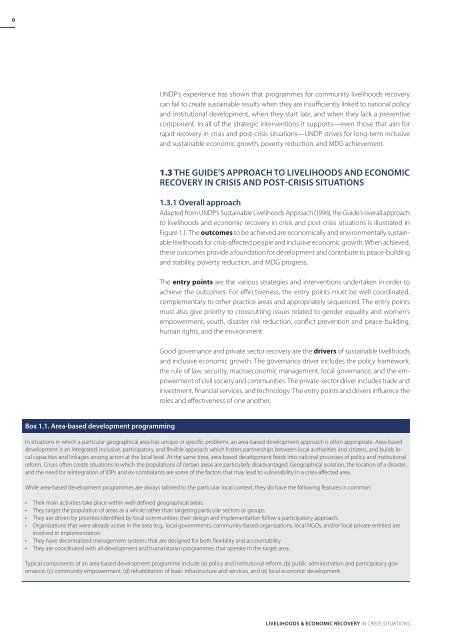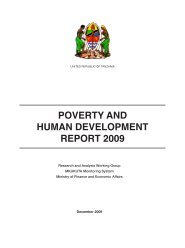Download PDF (4.08 MB) - ReliefWeb
Download PDF (4.08 MB) - ReliefWeb
Download PDF (4.08 MB) - ReliefWeb
You also want an ePaper? Increase the reach of your titles
YUMPU automatically turns print PDFs into web optimized ePapers that Google loves.
6<br />
UNDP’s experience has shown that programmes for community livelihoods recovery<br />
can fail to create sustainable results when they are insufficiently linked to national policy<br />
and institutional development, when they start late, and when they lack a preventive<br />
component. In all of the strategic interventions it supports—even those that aim for<br />
rapid recovery in crisis and post-crisis situations—UNDP strives for long-term inclusive<br />
and sustainable economic growth, poverty reduction, and MDG achievement.<br />
1.3 The Guide’s Approach to Livelihoods and Economic<br />
Recovery in Crisis and Post-Crisis Situations<br />
1.3.1 Overall approach<br />
Adapted from UNDP’s Sustainable Livelihoods Approach (1996), the Guide’s overall approach<br />
to livelihoods and economic recovery in crisis and post-crisis situations is illustrated in<br />
Figure 1.1. The outcomes to be achieved are economically and environmentally sustainable<br />
livelihoods for crisis-affected people and inclusive economic growth. When achieved,<br />
these outcomes provide a foundation for development and contribute to peace-building<br />
and stability, poverty reduction, and MDG progress.<br />
The entry points are the various strategies and interventions undertaken in order to<br />
achieve the outcomes. For effectiveness, the entry points must be well coordinated,<br />
complementary to other practice areas and appropriately sequenced. The entry points<br />
must also give priority to crosscutting issues related to gender equality and women’s<br />
empowerment, youth, disaster risk reduction, conflict prevention and peace-building,<br />
human rights, and the environment.<br />
Good governance and private sector recovery are the drivers of sustainable livelihoods<br />
and inclusive economic growth. The governance driver includes the policy framework,<br />
the rule of law, security, macroeconomic management, local governance, and the empowerment<br />
of civil society and communities. The private-sector driver includes trade and<br />
investment, financial services, and technology. The entry points and drivers influence the<br />
roles and effectiveness of one another.<br />
Box 1.1. Area-based development programming<br />
In situations in which a particular geographical area has unique or specific problems, an area-based development approach is often appropriate. Area-based<br />
development is an integrated, inclusive, participatory, and flexible approach which fosters partnerships between local authorities and citizens, and builds local<br />
capacities and linkages among actors at the local level. At the same time, area-based development feeds into national processes of policy and institutional<br />
reform. Crises often create situations in which the populations of certain areas are particularly disadvantaged. Geographical isolation, the location of a disaster,<br />
and the need for reintegration of IDPs and ex-combatants are some of the factors that may lead to vulnerability in a crisis-affected area.<br />
While area-based development programmes are always tailored to the particular local context, they do have the following features in common:<br />
• Their main activities take place within well-defined geographical areas.<br />
• They target the population of areas as a whole rather than targeting particular sectors or groups.<br />
• They are driven by priorities identified by local communities; their design and implementation follow a participatory approach.<br />
• Organizations that were already active in the area (e.g., local governments, community-based organizations, local NGOs, and/or local private entities) are<br />
involved in implementation.<br />
• They have decentralized management systems that are designed for both flexibility and accountability<br />
• They are coordinated with all development and humanitarian programmes that operate in the target area.<br />
Typical components of an area-based development programme include (a) policy and institutional reform, (b) public administration and participatory governance,<br />
(c) community empowerment, (d) rehabilitation of basic infrastructure and services, and (e) local economic development.<br />
Livelihoods & Economic Recovery in Crisis Situations





